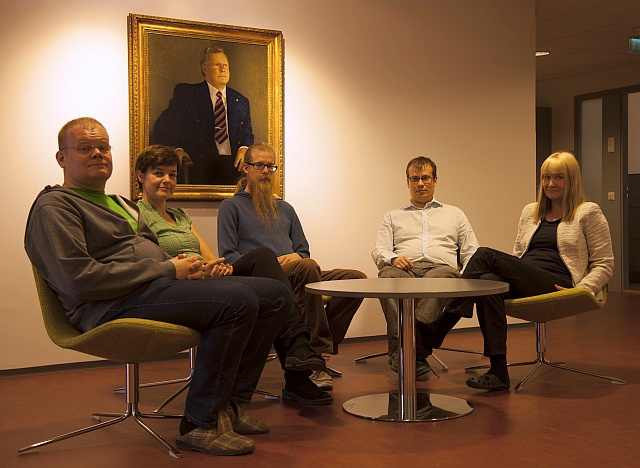Text: Helena Laaksonen Picture: Outi Törnblom
The experts of the FSD created the Data Service Portal Aila
Objective: Fast delivery of Data and Satisfied Customers
The Finnish Social Science Data Archive developed the Data Service Portal Aila in-house, with project funding received from the Academy of Finland. Developing the service portal was a huge effort, in which most of the staff participated.
Five employees from the FSD’s Information Services and Technical Services were interviewed for this article. In addition to their efforts, many other archive employees spent hours upon hours in developing the contents and features, testing, translating and providing comments on the service.
First there was a dream
Manager for Technical Services, Senior Systems Analyst Matti Heinonen remembers that the dream of developing a service portal materialised as long as ten years ago. When the UK Data Archive (UKDA) launched its data portal, the dream took a definite form and people at the FSD thought that they would need such a service, as well. However, the FSD did not have the resources to develop the data portal until it received research infrastructure funding, provided by the Academy of Finland for the first time in 2010.
"When funding was awarded for five years, it was a long enough time period for us to begin working on creating the service," Matti Heinonen explains. He says that the timing was also right in terms of human resources. In the Technical Services, a suitable project group could be formed right at the beginning of the funding. Systems analysts Jani Hautamäki and Toni Sissala both performed their civilian service at the data archive and, after the service, continued working in software development as employees.
When the application for research infrastructure funding was being written, FSD staff did not really realise how arduous the project would be in practice. In the application, the service portal was still a very abstract concept. Development Manager Arja Kuula-Luumi says the process was surprising in many ways.
"I hadn’t quite understood how much has to be taken into consideration technology-wise when some feature is to be implemented. In the same way, people in Technical Services did not a have complete understanding of the full process involved in Information Services," she says. "A whiteboard was used a lot when both groups tried to explain things in as simple manner as possible, over and over again."
Views and expectations were conciliated and flexibly modified as the project progressed.

The interviewees from left to right: Matti Heinonen, Hannele Keckman-Koivuniemi, Toni Sissala, Jani Hautamäki and Arja Kuula-Luumi.
In-house brings flexibility
The representatives of both Technical and Information Services agree on the greatest advantage of an in-house project as compared to outsourcing. When a service is produced in-house it is possible to flexibly change course and reformulate specifications and expectations. "It’s easier to say 'this should be done in another way' in an in-house project. Changes usually cause delays in the schedule. If plans need to be changed in an outsourced project, the company responsible will kindly ask you where to send the invoice for this extra work," Heinonen jokes.
Toni Sissala thinks one great advantage of in-house production is that the organisation has all the know-how, which can be utilised in implementation, training, maintenance and making changes in the software.
Creating the data service has taught archive staff a great deal and also influenced work processes. In Technical Services, a great deal of technological groundwork was done, which will be useful for other future services. - "For instance, we will, in the future, use the authentication solution we developed to authenticate users from institutions outside the HAKA Identity Federation," Heinonen says.
Harmonising the conditions of use
When the data delivery system based on paper forms was still in use, the archived data had a great variety of conditions of use, even though the basic types of conditions were very similar to the ones used today. Some deposit agreements had to be renewed in order to make the data available on the service portal. Information Services went through the agreements of all archived datasets. Renewing the agreements took longer than estimated.
The multitude of usage conditions was harmonised by creating four distinct usage classes. A dataset can be openly available; used for research, teaching and study; used only for research (including Master’s theses); or used only with special permission from the original researcher(s).
"Even after launching Aila, we have had to define in more detail what we mean by research and to whom we can actually deliver data," Information Services Specialist Hannele Keckman-Koivuniemi says.
The need to define who can download data was spurred by access applications received from people outside the Haka Identity Federation. A username will normally be issued only if the person applying for it studies, teaches or does research in a university, university of applied sciences or other research institute. Individuals not belonging to these organisations can browse study descriptions but can only download datasets that are openly available for all users.
Feedback from users stimulates further development
The developers of the data service portal are satisfied with the end result, but there is naturally always room for improvement. Both Information Services and Technical Services have ideas on how to improve the service. Customers have provided some ideas as well. The archive welcomes user experiences on and suggestions relating to Aila. The suggestions will be implemented within the limits of our resources.
More information
- Aila Data Service
- Send feedback about Aila to FSD User Services or Technical Services: Contact Details
- See also Producing Aila Interface in English